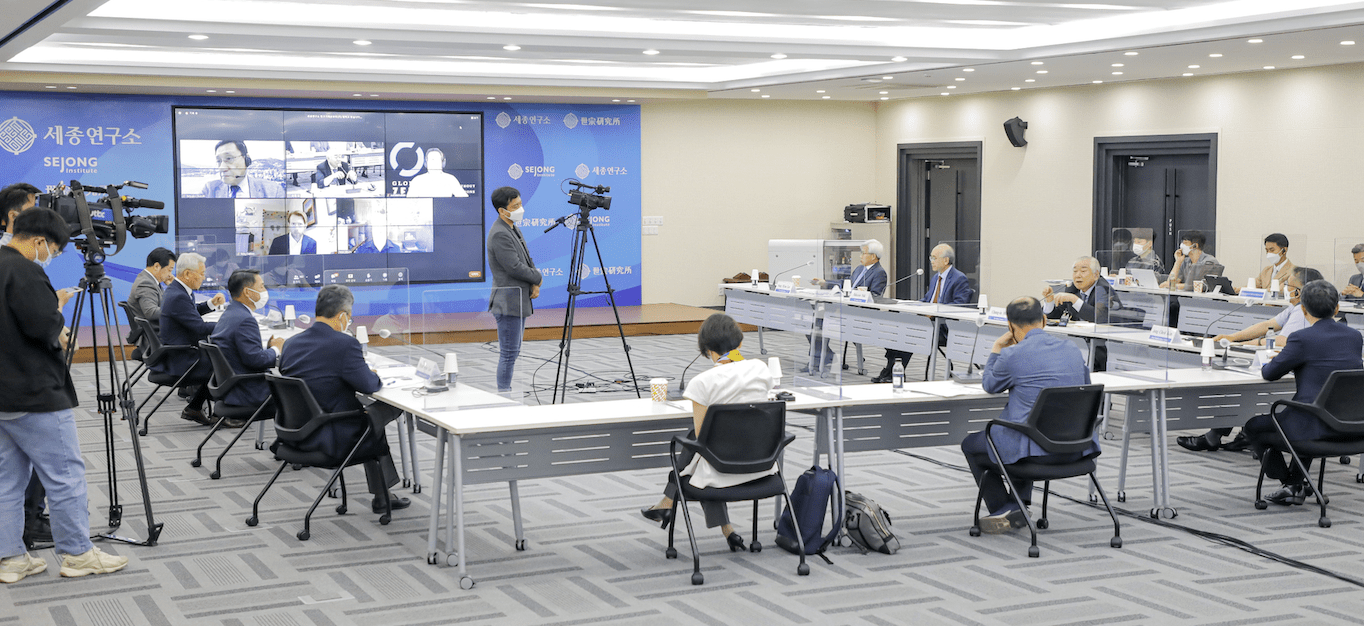Assessing Northeast Asia Nuclear Domino: South Korean Responses
On May 14th, 2021 from 9-11:30 AM KST, the international joint seminar Assessing Northeast Asia Nuclear Domino: North Korean Nuclear Threat and South Korean Responses took place both in-person at the Sejong Institute in Korea and online on zoom to see ROK civil society leaders and strategic experts convene to discuss the primary drivers of nuclear proliferation on the one hand, and of the risk of war on the other.
This event was cohosted by APLN, the Sejong Institute, Carnegie Endowment for International Peace, Pugwash Japan, The Research Institute of National Security Affairs of the Korea National Defense University (KNDU), The Korea Nuclear Policy Society (KNPS), and was supported by the Open Society Foundations.
Opening remarks were given by Jong Cheol Kim, President of Korea National Defense University (KNDU), Haksoon Paik, President of the Sejong Institute, and Sang Hyun Lee, President of Korea Nuclear Policy Society (KNPS) and Senior Research Fellow at the Sejong Institute, followed by an introductory speech by APLN Vice Chair Chung-in Moon.
The event featured 3 panelists presenting on a variety of issues regarding nuclear policy on the Korean peninsula. The panelists included:
- Jungsup Kim, Senior Research Fellow at the Sejong Institute and Former Deputy Defense Minister, presenting “Assessing North Korea’s Nuclear and Missile Threats: An Update”
- Wooksik Cheong, President of Korea Peace Network, presenting on “South Korean Debates on Countervailing Strategies: Independent Nuclear Weapons, Re- transfer of American Tactical Nukes, and NATO style Nuclear Sharing”
- Jiyoon Kim, Senior Research Fellow at the Institute of Democracy Studies and Education, presenting on “South Korean Attitudes toward the Nuclear Weapons Development: A Survey Analysis”
The event then concluded with a discussion of the topics presented led by nuclear policy experts. Featured speakers included:
- Peter Hayes, Research Director at APLN and Director of the Nautilus Institute
- Sang Hyun Lee, President of Korea Nuclear Policy Society
- Toby Dalton, Senior Fellow at the Carnegie Endowment for International Peace
- Jon Wolfsthal, Former Special Assistant to President Obama for Nonproliferation
- Sangchul Lee, Former Deputy National Security Advisor to the ROK President Moon
- Tatsujiro Suzuki, Vice Director at the Research Center for Nuclear Weapons Abolition, Nagasaki Univeristy, Japan (RECNA)
Jungsup Kim on assessing DPRK’s latest nuclear and missile threats
“It is necessary to be mindful of the possibility that hardware-level measures such as relocation of tactical nuclear weapons or the introduction of a NATO-style nuclear-sharing system may not have meaningful military utility and may only cause side effects.”
“In the Korean Peninsula, destructive military forces are saturated in a narrow battlefield environment, & stable management of bilateral deterrence situations is considered more cautious than an obsession with impossible defense or a pursuit of dangerous expansion advantage.”
Wooksik Cheong on “South Korean Debates on Countervailing Strategies: Independent Nuclear Weapons, transfer of US tactical nuclear weapons, and NATO-style Nuclear Sharing”
“The fundamental purpose of deterrence is to make the other party realize that the benefits they seek from armed attacks would be outweighed by the losses that result from such attacks”
“Instead of trying to define denuclearization on the Korean Peninsula, which is hard to agree on, a new start can be promised if the NWFZ that has already existed internationally is used as the definition and final state of denuclearization in the two Koreas.”
Jiyoon Kim on “South Korean Attitudes toward Nuclear Weapons Development: A Survey Analysis”
“There is a generational gap that demonstrates how differently the young generation of ROK perceives the nuclear development of the country from the elderly. The younger generation supports a strong ROK-US alliance & generally has stronger negative sentiments toward the DPRK.”
“The ROK public’s pro-nuke attitude can be quickly changed when they are informed of hypothetical restraints from the international community and the United States. The younger generation is relatively more concerned with opposition from the US than the older generation.”
Peter Hayes on DPRK nuclear policy and future steps
“Strategically, deterrence should be the last goal after compellence and reassurance, because this goal is relatively easier to achieve than the other two. We need to understand what is our primary focus, or our efforts will be missing the main game in this exchange”
Sang Hyun Lee on the denuclearization of the Korean Peninsula
“We should not be trying to solve the problem of nuclear weapons in the Korean Peninsula by creating more nuclear weapons, but by continuing to eliminate them. If we want DPRK to denuclearize, we need to create that level of trust and assurance to make that happen. ”
Toby Dalton on the US-ROK alliance and the DPRK nuclear dynamic
“Despite US efforts over several administrations to try to drive the need for nuclear deterrence down to a lower level, if we try to apply more nuclear capability to the problem at hand, how would that help in increasing the credibility of the US and their alliances?”
Jon Wolfsthal on redefining the goals of a US-ROK alliance and strategy towards denuclearizing the Korean Peninsula
“We need to pinpoint what we’re trying to solve in the ROK. We’re dealing with a political problem, not a military one, and reassurance is not an endpoint but a process. You can have fewer nuclear weapons & have a strong alliance or have lots of weapons & have a very weak alliance.”
Sangchul Lee on DPRK nuclear policy

